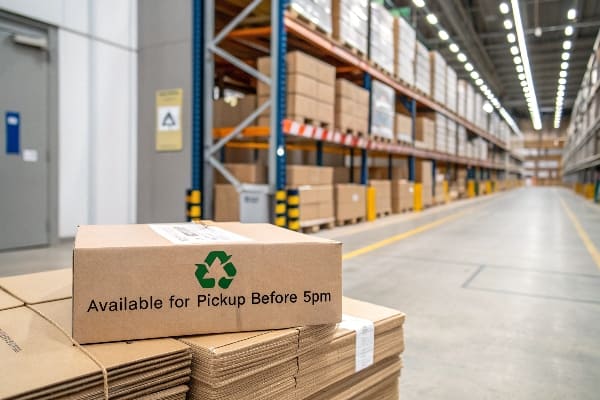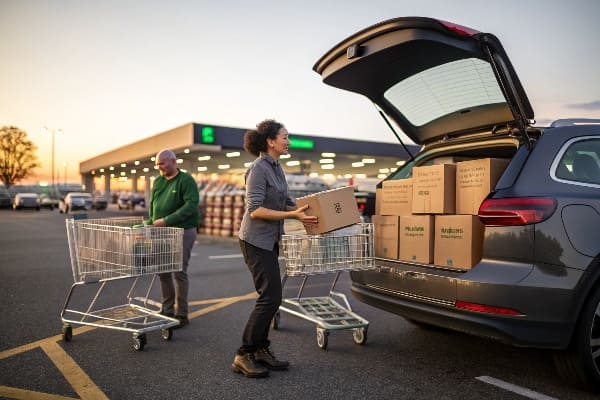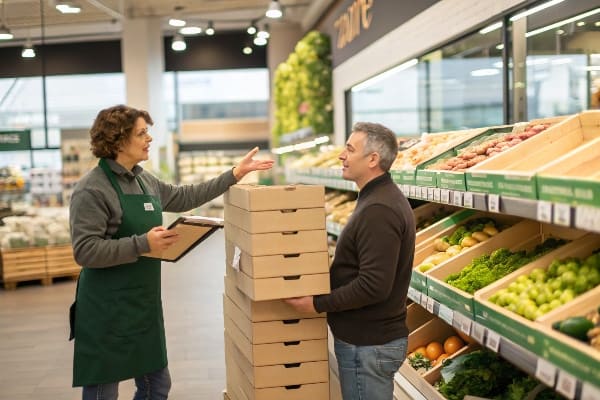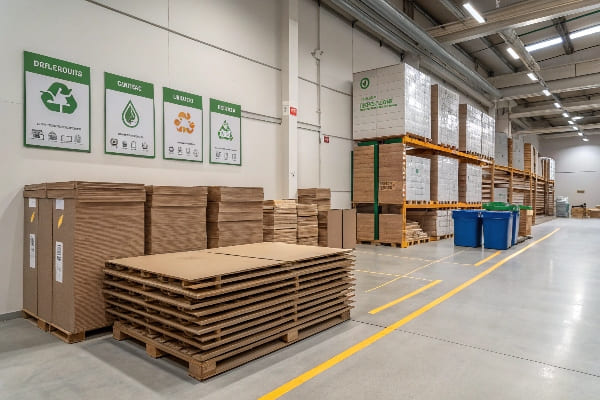I see full carts of boxes go to recycling every day. I feel the urge to ask. I worry I will sound rude. I need a simple plan.
Walk up with a smile, ask a manager by name if possible, say you reuse boxes for moving or projects, name the size you want, ask the best pickup time after deliveries, offer your phone number, and say thanks even if they say no.

I keep my ask short and clear. I respect their time. I aim for times when staff feels less stress. I leave a card. I often get a yes on my next visit. Small wins build trust.
How do I ask for free cardboard boxes?
I feel shy the first time. The words feel clumsy. I need a script I can use in any store.
Say: “Hi, I am looking for clean cardboard boxes you plan to recycle. Do you have any medium or large ones? When is a good time to pick them up?” Keep it short. Be polite. Offer contact info.

| Step | Words I use | Why it works |
|---|---|---|
| Greet | “Hi, how are you?” | Sets a friendly tone. |
| State need | “I reuse boxes for moving / displays.1” | Gives a clear reason. |
| Be specific | “I need double-wall or liquor-size.” | Helps staff sort. |
| Ask timing | “When is best to pick up?” | Fits their schedule. |
| Share contact | “Here is my number.” | Makes it easy to text. |
| Exit well | “Thank you either way.” | Leaves goodwill. |
Notes from my shop floor
I run PopDisplay in Shenzhen. I make cardboard displays for brands2. I stand in back rooms with stock teams often. I see what helps. Simple and honest words win. I do not say “spare” or “waste” in a harsh tone. I say “reuse” and “recycle” with a smile. I do not block aisles. I wait for a pause. I keep my hands visible. I never open compactors or sealed bales. I bring tape to flatten boxes fast so staff does not do extra work. When I mention I build displays, people get curious. I show a small photo book. This breaks the ice. Many times the manager says, “Come back after the truck on Tuesday.” I write it down and I show up on time. Trust turns into a steady stream of clean boxes.
Will stores give you cardboard boxes?
I wonder if stores even allow this. Policies change by chain and by manager. I want the truth before I drive.
Yes, many stores will give boxes that are clean and safe to release, but policies differ by store, shift, and manager. Ask at customer service, avoid busy hours, and accept “no” with grace. Try again another day.

What affects the answer
| Factor | What it means | What I do |
|---|---|---|
| Safety | Box cannot have blades, spills, or pests. | I ask for dry, food-safe areas first. |
| Timing | Staff compacts after trucks. | I come right after restock. |
| Volume | Some chains bale cardboard. | I target smaller stores too. |
| Cleanliness | Leaks or odors kill the ask. | I refuse dirty boxes. |
| Liability | Some stores ban backroom access. | I wait at the counter. |
Real cases I see
Big box chains often bale cardboard on a set schedule. The baler turns boxes into dense cubes for pickup. Staff cannot break this flow. I do not push. I ask for boxes that do not fit the baler, like heavy liquor cartons or printed display outers. Specialty shops like pet stores, pharmacies, and book stores keep neat boxes near the front. They want space back. They say yes more often. Independent stores help most if I make pickups smooth. I bring a dolly. I stack safely. I leave space clean. When I act like a partner, my “yes” rate goes up. As a display maker, I also look for high-strength double-wall boxes3. These travel well and hold shape for prototypes. I mark sources on a simple map and rotate weekly. Consistent visits beat random luck.
How do you ask supermarkets for boxes?
Supermarkets look busy and loud. Staff pushes pallets fast. I need a plan that fits their rhythm.
Go to customer service or ask the stockroom manager right after restocking. Request produce, cereal, or liquor boxes. Bring gloves, flatten fast, and keep aisles clear. Thank the team and confirm the next pickup day.

Best times and scripts that work
| Time window | Why it helps | Script I use |
|---|---|---|
| Early morning4 | Night crew just finished. | “Do you have produce or cereal boxes I can take now?” |
| Late evening | Restock slows, fewer shoppers. | “Any clean liquor cartons before compacting?” |
| Midweek | Trucks arrive on set days. | “Which day is your big truck?” |
| After holidays | Extra packaging comes in. | “Can I help clear clean boxes today?” |
Field notes from display builds5
I build PDQ trays and floor displays. I test them with real retail flow. Supermarket boxes vary a lot. Produce boxes are strong and have hand holes. Liquor boxes are double-wall and great for heavy items. Cereal and cracker boxes are light but clean and uniform. I sort by strength at pickup so I do not waste time later. I keep a short log in my phone: store name, manager name, best day, typical sizes. This turns one-off wins into a route. When I use boxes for mock-ups, I tape edges and add corner boards to mimic corrugated E- or B-flute we use in displays. This saves my team money in early tests. It also keeps waste low. Many managers like that. They see I respect materials, so they keep boxes for me.
How to get a lot of cardboard for free?
I want volume, not a few boxes. I need a repeatable system. I need a route and simple tools.
Build a weekly route of grocery, liquor, pharmacy, bookstore, and office supply stores. Add warehouses, bike shops, and furniture stores. Join local apps. Set pickup days. Bring a dolly, tape, gloves, and tarps. Show up on time.

My high-volume playbook
| Source | What I get | Tip for speed |
|---|---|---|
| Liquor stores | Thick double-wall cartons | Ask before weekend rush. |
| Bookstores | Clean, uniform shipper boxes | Offer to flatten on site. |
| Pharmacies | Small sturdy boxes | Great for glass or parts. |
| Furniture stores | Extra-large sheets | Call ahead for pickup window. |
| Bike shops | Long, rigid cartons | Bring a van or roof rack. |
Why this system works for my display business
I run three production lines. I prototype often. Free cardboard cuts early costs. I keep quality high by choosing dry and odor-free stock. I stack by size, then by flute strength when I can see the edge. I cut sample blanks with a safety knife and a metal ruler. I test folds and tabs like we use in retail displays. I can simulate shelf trays, counter units, and floor stands fast. I keep photos and share them with buyers, like David from Barnett Outdoors. He needs strong, clean, on-time solutions for crossbow displays. Free cardboard lets me try many angles and header sizes in one day. I move to fresh board for final samples once the structure works. This saves time and keeps waste low. It also shows partners that I take sustainability and cost control6 seriously.
Conclusion
Ask kindly, be specific, time your visit, and build a route. Show up on time. Keep it clean. Small yeses turn into steady supply.
Exploring this resource will provide insights into sustainable practices and the advantages of reusing boxes, enhancing your understanding. ↩
This link will offer valuable strategies and examples of how brands can utilize cardboard displays to boost visibility and sales. ↩
Explore this link to understand the benefits and applications of high-strength double-wall boxes in various industries. ↩
Exploring this resource will reveal insights on optimizing box collection during early hours, enhancing efficiency. ↩
This link will provide strategies for documenting display builds, improving your workflow and organization. ↩
Learn effective strategies for balancing sustainability with cost control to improve your business operations. ↩




